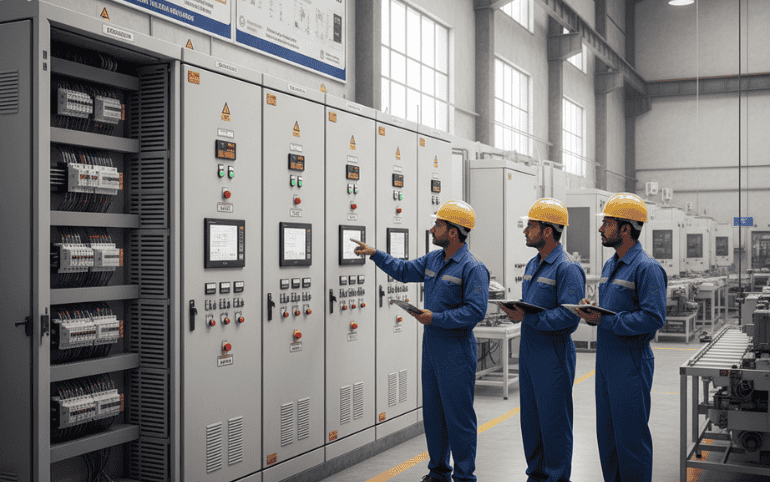India’s industrial sector is rapidly evolving. Rising electricity costs, stricter sustainability policies, and national goals around carbon reduction are pushing factories and processing units to adopt smarter technologies. Among these, modern industrial control panels have emerged as one of the most influential tools for energy optimization and sustainability.
Today’s electrical control panels are no longer simple switching devices — they are intelligent systems built with VFDs, APFC panels, IoT-enabled monitoring, automation controls, and power management tools that significantly reduce energy consumption while improving process efficiency.
This blog explores how modern control panels contribute to India’s energy-efficiency targets, their role in sustainability, and real case studies demonstrating their measurable impact.
1. Energy-Efficient Components Inside Modern Control Panels
Modern control panels are designed with advanced components that directly reduce electrical wastage and improve system efficiency.
a) Variable Frequency Drives (VFDs): Controlling Motor Power Consumption
Motors and pumps consume 50–60% of total industrial electricity in India. Running them at fixed speeds—as traditional systems do—leads to high wastage.
VFD-integrated control panels help by:
- adjusting motor speed based on real demand
- reducing energy usage by 20–60%
- minimizing mechanical stress and increasing motor lifespan
- enabling soft-start to avoid high inrush currents
- improving process accuracy and stability
Industries benefiting: manufacturing units, chemical processing, HVAC systems, pharma utilities, wastewater plants, textile mills, and building management systems.
b) APFC Panels: Eliminating Power Factor Penalties & Line Losses
Most Indian DISCOMs impose penalties when power factor drops below 0.95.
Automatic Power Factor Correction (APFC) Panels are designed to maintain optimal PF levels.
APFC panel advantages:
- maintains PF at 0.98–1.0 dynamically
- avoids costly PF penalties
- reduces transformer and cable loading
- minimizes transmission losses
- stabilizes voltage supply for sensitive machinery
These panels greatly improve electrical efficiency while ensuring compliance with utility norms.
2. Real-Time Energy Monitoring & Automated Energy Optimization

Advanced MCC, PCC, and PLC-based control panels support IoT, SCADA, and smart energy monitoring systems, giving plant operators complete visibility into power usage.
a) Real-Time Energy Monitoring
Smart meters and analyzers inside control panels help track:
- per-machine energy consumption
- peak load times
- harmonics and reactive power
- system voltage irregularities
- motor efficiency
- overall plant energy leakages
This data is essential for energy audits, predictive maintenance, and reducing wastage.
b) Automated Energy-Saving Functions
Control panels equipped with PLC/SCADA automation enable:
- automatic shutdown of idle machines
- programmable start-stop schedules
- optimized control of HVAC and utility systems
- load balancing during peak hours
- predictive maintenance alerts
- automatic switching of capacitor stages (in APFC panels)
- pump and blower optimization based on process load
Automation ensures consistent energy savings without relying on manual supervision.
3. Reducing Carbon Footprint Across Indian Industries
Energy-efficient control panels help industries cut operational emissions by reducing total electricity demand. Since India’s grid still relies heavily on coal, every kWh saved reduces CO₂ output by a measurable amount.
Industries experiencing the biggest carbon reduction impact include:
a) Manufacturing & Heavy Engineering
VFD MCC panels reduce the high energy consumption of motors, conveyors, compressors, and molding machines. Plants report 20–50% motor-related energy savings.
b) Pharmaceutical Plants
Pharma facilities run intensive HVAC systems, AHUs, ROs, WTPs, and cleanrooms—major power consumers.
Control panels help:
- optimize HVAC load
- ensure process stability
- reduce overall utility demand
- maintain strict GMP & compliance standards
c) Water & Wastewater Treatment Plants
Pumps and blowers run continuously in WTP/STP plants.
VFD-based pump control panels help reduce energy usage by 30–45%, especially during low flow periods.
d) Commercial Buildings, Malls & Data Centers
Advanced control panels manage:
- chiller plants
- cooling towers
- ventilation systems
- lighting automation
- DG synchronization
Reducing energy consumption directly cuts carbon emissions and boosts operational efficiency.
4. Government Energy Efficiency Initiatives Supporting Control Panel Adoption

The Government of India is actively driving industrial energy efficiency through policies and regulations.
Key Policies Supporting Advanced Control Panels:
a) PAT Scheme (Perform, Achieve & Trade) – Bureau of Energy Efficiency
Targets high energy-intensive sectors (cement, steel, textiles, aluminum, paper, fertiliser).
Industries meeting energy reduction targets receive financial incentives.
Efficient control panels help achieve PAT goals quickly.
b) ECBC – Energy Conservation Building Code
Mandates energy-efficient electrical & HVAC systems for commercial buildings.
Automation-based control panels help achieve ECBC compliance.
c) National Solar Mission
Smart control panels assist with:
- solar synchronization
- hybrid power management
- net metering
- smart load distribution
d) State DISCOM Power Factor Penalty Regulations
Most Indian states penalize low PF and harmonics.
APFC panels ensure compliance and reduce monthly bills.
e) Smart Manufacturing & Industry 4.0 Push
Government incentives encourage IoT, automation, and digital manufacturing.
Control panels are the central infrastructure behind these technologies.
5. Case Studies: Indian Industries Achieving Real Energy Savings
Below are real-world examples (based on typical industrial results) showing measurable energy savings from advanced control panel adoption.
Case Study 1: Textile Plant in Gujarat
Problem: High energy consumption due to constant-speed motor operation
Solution: VFD-based MCC panels
Results:
- 38% reduction in motor power use
- Better process temperature control
- ROI within 7 months
Case Study 2: Pharma Plant in Baddi (Himachal Pradesh)
Problem: Frequent PF penalties & utility instability
Solution: APFC panel + smart energy analyzer panel
Results:
- PF improved from 0.82 → 0.99
- Saved ₹1.2 lakh/month in penalties
- Reduced transformer loading by 12%
Case Study 3: Water Treatment Plant in Maharashtra
Problem: Pumps running unnecessarily at full speed
Solution: VFD-driven pump control panels
Results:
- Up to 45% energy savings
- Extended pump life
- Improved flow control reliability
Case Study 4: Automotive Components Plant in Noida
Problem: Lack of visibility on peak loads
Solution: IoT-integrated smart MCC panel
Results:
- 15% reduction in total energy consumption
- 20% lower downtime through predictive alerts
- Automated reporting for management dashboards
Conclusion: Control Panels Are Critical to India’s Energy-Efficient Future
Modern industrial control panels — equipped with VFDs, APFCs, PLC automation, and real-time monitoring — are transforming India’s industrial landscape. They help factories reduce energy costs, improve power quality, enhance operational efficiency, and significantly cut carbon emissions.
As India moves toward a sustainable and energy-efficient industrial future, advanced control panels will play a foundational role in:
- lowering energy consumption
- meeting government compliance goals
- supporting carbon reduction commitments
- enabling smart manufacturing
- reducing operational expenses
- improving overall plant performance
Industries that adopt intelligent control panels today will have a major competitive advantage tomorrow.






